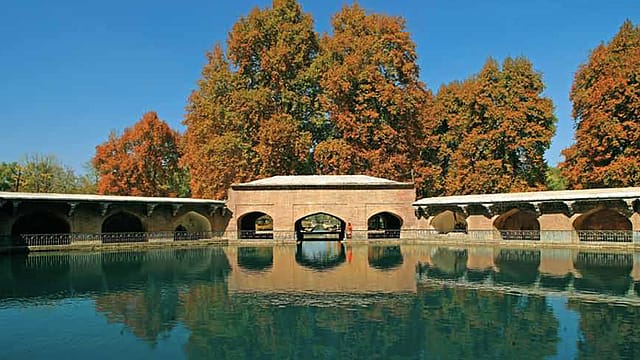Reimagining Kashmir
ADVERTISEMENT

At the great Ashmolean Museum at Oxford, the world’s oldest public museum, I was looking at an old Kashmiri shawl replete with a design most Indians call the buta but is known in the West by the name paisley.
Few in India, or even outside, would know that this ubiquitous design is a contribution of the place Bill Clinton once termed as the most dangerous in the world – Kashmir. This is the sort of story that is never told about Kashmir.
On a happier note, one of the finest examples of this transcontinental exchange of ideas in textile is the journey of the buta or the paisley motif. These appeared in shawls in Kashmir as early as the 11th century and their first major champion was the Kashmiri king Zain-ul-Abidin who brought in weavers from around the world including Persia and Central Asia to Kashmir. The emperor Akbar fell in love with the buta and had his weavers put them on khilat or robes of honour – some say the paisley comes from the royal insignia of a feather.
By the 18th century, the buta had arrived in Europe through English officers who had been gifted shawls by Kashmiri nobility. Soon demand for these exquisite shawls grew and one is said to have been presented by Napolean Bonaparte to his wife Josephine. Enamoured by their quality, Josephine became a collector of Kashmiri shawls and started a rage among the European aristocracy.
January 2026
Netflix, which has been in India for a decade, has successfully struck a balance between high-class premium content and pricing that attracts a range of customers. Find out how the U.S. streaming giant evolved in India, plus an exclusive interview with CEO Ted Sarandos. Also read about the Best Investments for 2026, and how rising growth and easing inflation will come in handy for finance minister Nirmala Sitharaman as she prepares Budget 2026.
Soon enough the design slipped from the shawls into other garments as an embroidery or a print – the paisley had become a rage. Demand outstripped supply and mills in England and Scotland began to copy the design so that demand could be met – they could not, though, get the extremely fine wool from Kashmir, so the design was applied on all kinds of fabrics including silks and cottons. So popular did the manufacture become in one town in Scotland that it even the design and the name of the town merged into one - Paisley.
After falling a bit out of fashion in the late 19th century, the paisley or buta was back in fashion by the 20th – appearing everywhere, including on the clothing of The Beatles, and continues even today. It is just that almost no one connects this story to Kashmir.
But this is not the only story of Kashmir that has gone barely noticed.
About five years ago, at a particularly desultory meeting of Fortune India, we had a eureka moment. There was a bank which was part of the Fortune India 500 India list – or the 500 biggest, most important companies in India, the backbone of the Indian economy so to speak – and no one seemed to know much about it.
This was a bank called the Jammu and Kashmir Bank. It is one of India’s best-run banks of its size and is consistently profitable. It is owned by the government and wholly managed by locals. Local Kashmiris who work for the bank have regularly risked their lives to beat terrorism – including an attack that burnt down one of its main centres, and deliver services, including desperately-needed money, to their customers. Not only the bank, but the Jammu and Kashmir Entrepreneurship Development Institute has been attacked by terrorists – it is worth considering with care why every positive development in Kashmir is murderously attacked.
A few days ago, Shamika Ravi, who is director of research at Brookings India and serves on the Prime Minister’s economic advisory council, tweeted out a set of four charts from the apex Reserve Bank of India which show that Kashmir receives more development spend per capita than the rest of India and has far better health infrastructure than the rest of India.
It also has twice the number of schools per household than the rest of India, and greater financial inclusion (both rural and urban), and deeper mobile phone connectivity compared to average households in the rest of India.
And yet none of this is part of the stories that are told about Kashmir every day. This is a narrative of Kashmir that has never been allowed to be built about Kashmir. A people become the story that they tell about themselves, and that is told about them. There are several reasons why Kashmir is such a dangerous place but one of them – of particular importance at a time when the narrative battle is key – is the story that is told about it.
